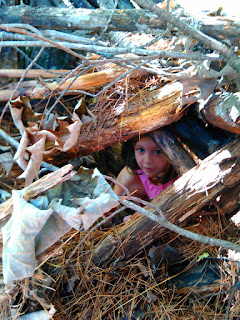Heart thumping, legs stretching, a forest preschooler slides
into the den between two trees at deer camp, narrowly escaping a friend in
pursuit. Safe…for now. The fox stalks outside, sniffing, searching,
but the mouse is out of sight.
At Forest Preschool
this fall many engaging games emerged around the predator/prey
relationship. Camouflage, in particular,
was a favorite activity on our morning walk through the meadow. Some days the children became coyotes and
rabbits; other days they transformed into hawks and mice or into a flock of
hungry crows in a farmer’s field. The
children invented multiple scenarios and never tired of sneaking and hiding and
being chased.
Along with the
familiar Vermont animals, there was another creature that accompanied us on our
journeys: this one larger and hungrier than all the others. Dinosaurs metamorphosed almost daily out of
predator or prey; a hunted mouse could easily transform before our eyes into a
fearsome t-rex that then became the hunter.

Excited to explore the activities and habits of the animals
that actually share our home with us, I initially resisted the persistent
appearance of this bygone reptile in our adventures. What do dinosaurs have to do with where we
are right now, I wondered? So I kept
watching and I began to understand that the dinosaurs are very much a part of
the ecology at NBNC, that is, the inner ecology of the children who play
here. Dinosaurs are the allies of young
children who, due to their size and age, inherently face new situations that
can be scary and challenging on a regular basis. As growing, developing human beings, children
desire and need to take risks…healthy risks.
And that is where the dinosaurs come in.
T-rex’s are fearsome creatures but unlike wolves and bears (or zombies),
they are undeniably extinct and therefore, safe. There is no chance of bumping into a
stegosaurus in the goldenrod. The only
thing that gives it life is imagination and the children are fully in charge of
that. Healthy risk – climbing trees,
sliding down hills, balancing on logs – can be scary, but like the dinosaurs,
just scary enough…for growth and learning.

At Forest Preschool, the children learn to calculate and navigate
manageable risk in their play. As their
teachers it is our job to enable that stretching process and ensure their
safety. It is through their own
self-chosen exploration that they will develop the resilience and self-reliance
so important to life.
Learning is exciting. And risky. And the dinosaurs are there to help.





